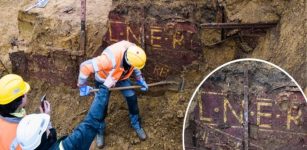Previously Unknown Hieroglyphic Inscriptions Found By Polish Researchers At Gebelein, Egypt
AncientPages.com - Science in Poland reports that dozens of previously unknown hieroglyphic inscriptions have been discovered by Polish researchers working at Gebelein, located on the Nile, about 40 km south of Thebes, in the New Valley Governorate, Egypt.
The inscriptions, which were found on the rocks near the temple of Hathor, contain prayers to deities and were made by pilgrims or priests, according to the researchers.

Inscriptions were found on a rock surface near the 3.5 thousand years old rock-cut chapel of the goddess Hathor. Image credit: PAP/Science in Poland
Polish researchers determined that the temple was founded during the reign of Hatshepsut, 3.5 thousand years ago, and that it was dedicated to goddess Hathor.
"The temple scribe Senebiu adores Hathor Lady of Gebelein" - reads one of the inscriptions discovered by a team of Polish scientists working at Gebelein. Like a few dozen others, it was engraved on a rock surface near the 3.5 thousand years old rock-cut chapel of the goddess Hathor.
"Inscriptions discovered by our mission are an invaluable source for research on popular religious beliefs,” Wojciech Ejsmond, PhD student at the Antiquity of Southeastern Europe Research Center of the University of Warsaw, who led the Polish expedition working at Gebelein, told PAP.
“We know Egyptian beliefs primarily from official texts from monumental temples and tombs, made for royals and elite members."

The work with these inscriptions located in such difficult to approach places – definitely wasn’t easy and required both camera booms and equipment. Image credit: PAP/Science in Poland
Translation made by Egyptologist Dawid F. Wieczorek shows that the discovered engravings are mainly short religious inscriptions, in which the scribes worship deities. Some could be created on the various occasions, for example religious festivals.
The inscriptions, that were engraved or engraved and painted, date back from 1770 BC to 1400 BC, from late Middle Kingdom to the beginning of the New Kingdom.
Hathor was worshiped in the nearest temple, and Anubis and Sobek in the other places in the region. Signatures are visible in some of the inscriptions, allowing the researchers to learn the names of ancient scribes - for example Senebiu.
It’s also important to add that the work with these inscriptions located in such difficult to approach places – definitely wasn’t easy and required both camera booms and equipment.
AncientPages.com




















